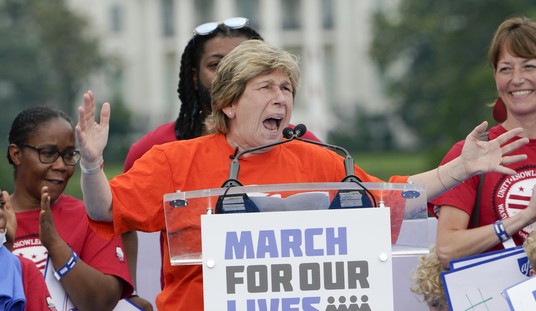The media-hyped recent Polls of Doom that are terrifying congressional Republicans are frauds.
Although President Obama isn’t at all interested in negotiating in good faith with his adversaries in the legislative branch because he views the current so-called government shutdown as a consciousness-raising opportunity, there is every reason to believe Senate Minority Leader Mitch McConnell (R-Ky.) and House Speaker John Boehner (R-Ohio) are throwing in their respective towels.
Let’s focus on the New York Times/CBS poll of Sept. 19-23. First, 19% of respondents are people who can’t even be bothered to register to vote, despite all the laws making it absurdly easy (such as when you get a driver’s license or sign up for welfare). There’s nothing inherently wrong with surveying “all adults” rather than registered voters or likely voters, as long as that is highlighted, underlined, made explicit in the news stories based on the poll — which didn’t happen.
The poll also seems to have oversampled certain groups compared to others. The ratio of people with children at home (who lean Republican) to people without children (who lean Democrat) should be about two-to-one, but, in the NYT/CBS sample, the ratio is 32-29, virtually a tie. Married people (who lean Republican) should outnumber never-married people (who lean Democratic by three-to-one, but, in the poll, it’s about two-to-one (53-27). Protestants (who lean Republican) should be 77-78% of the respondents, but they’re a mere 46%.
Conservatives should outnumber liberals by almost two-to-one, but the poll has the ratio at 34:23.
And people who claim not to have health insurance or health care coverage, which should be under 10% unless illegal aliens are included, constitute a whopping 16%.
Demographers might argue over these ratios, but as far as I can tell every case of apparent oversampling/undersampling favors the liberal or Democratic side. Honest errors would tend to be more evenly distributed and would balance each other out.
In the poll results, as reported by the New York Times and CBS, we don’t see the so-called “cross-tabs”—the data showing how each group responded to each question and how the groups compared to each other. Thus, it’s impossible to determine the precise degree to which sampling problems might have affected the results. It’s certainly enough to suggest that they’re off by several points on some of the close questions.
Now consider the bizarre wording of a question on Obamacare:
“Regardless of how you personally feel about the 2010 health care law, what would you like to see Congress do when it comes to the 2010 health care law? (1) Uphold the law and make it work as well as possible or (2) try to stop the law from being put into place by cutting off funds to implement it.”
Not only is the question five times the maximum length for a legitimate question, in my opinion, but it uses what people in politics call “weasel words” aimed at eliciting a particular response.
Those words: “make it work as well as possible.” Who’s against that? Amazingly, despite the slanted wording, 38% still favored defunding (with another 1% favoring blocking the law without defunding), and only 56% backed making it “work as well as possible.”
The reporting on that question from the NYT/CBS poll ignored the actual wording of question and misleadingly suggested people supported funding Obamacare, with no qualifiers. Here’s how the Washington Post reported the result: “[T]oday’s New York Times/CBS News poll finds that by 56-38, Americans support upholding Obamacare rather than defunding it . . . “
Here’s the wording of another question:
“In general, do you think it is acceptable for a President or members of Congress to threaten a government shutdown during their budget negotiations in order to achieve their goals, or is that not an acceptable way to negotiate?”
That’s called a leading question, the sort that a lawyer can’t ask a witness because the favored answer is made clear by the wording of the question. It’s 39 words, including “acceptable,” “threaten,” “shutdown,” “in order to achieve their goals,” “not an acceptable way to negotiate”—all terms that telegraph the pollsters’ idea of what the correct answer should be. Not surprising, the result was “acceptable,” 16% and “unacceptable,” 80%.
Another oft-reported question asked people is whom they would “blame” more in the case of a partial government shutdown. The results were: “Republicans in Congress,” 44%; “Barack Obama and Democrats,” 35%. But those figures include people who wouldn’t blame anyone—that is, people who support the idea of a shutdown. How many? Other polls have shown support for the shutdown ranging from the teens to the high 30s. The NYT/CBS poll, despite a biased wording on the question (“How do you feel about the possibility of a government shutdown—mostly satisfied or mostly frustrated?”) found 10% “mostly satisfied” with a shutdown. Another result showed 19% saying it would be “worth risking a shutdown of the federal government to defund the health care law.”
That’s enough to render meaningless any figure based on a who-do-you-blame question!
Imagine if people were asked, “Who do you blame for the Cowboys victory in their last game with the Redskins?” How would Cowboys fans answer that question—“blaming” the Cowboys for winning or “blaming” the Redskins for failing to stop the Cowboys or “blaming” the Redskins for trying to stop the Cowboys or what?
Failing to isolate the pro-shutdown people from the anti-shutdown people makes the nine-point difference between Republican “blame” and Democrat “blame” meaningless.
Yet the poll was widely reported as supporting the idea that Republicans were getting the “blame.”
Despite all the flaws, people ideologically aligned with the president were found on many key measures to be in the minority or outside the mainstream.
The poll indicated that only 5% of respondents had “a lot” of confidence in the Federal Reserve’s ability to promote economic growth (“some,” 27%; “not much,” 25%; “none,” 13%). That means that, on that issue, a whopping 5% agree with the President’s position on this issue.
Only 30% thought Barack Obama cares “a lot” about “the needs and problems of people like yourself.” (He cares “some,” 32%; “not much,” 16%; “not at all,” 21%.)
Only 17% strongly approved of “the health care law that was enacted in 2010,” with 34% strongly disapproving. The law will “hurt the national economy,” 49; “improve the national economy,” 26%.
Should the debt ceiling be raised “because the government must pay its existing bills and obligations,” or should the debt ceiling be raised with offsetting spending cuts, or not raised at all? Despite the weasel words about bills and obligations, part of a question longer than 100 words long, the result was “raised without conditions,” 17%; “raised with spending cuts,” 55%, and “not raised,” 24%. In other words, President Obama’s position, raising the debt ceiling without offsetting spending cuts, was opposed by 17% to 79% (55% + 24%). [In a September 20-23 Bloomberg poll giving an either-or choice between an unconditional increase in the debt ceiling versus “requiring spending cuts when the debt ceiling is raised even if it risks default,” respondents opposed the unconditional increase by 61-28.]
It turns out that the mainstream position wins even when the poll is otherwise tilted toward the Left. Other recent polls have found people favoring “smaller government with fewer services” over “bigger government with more services’ by 60-35, and classifying the federal government as “too powerful” versus “not powerful enough” by an astonishing 60-7! That’s right: The president’s position is shared by seven percent of the population, according to one recent poll (Gallup).
In conclusion, when a public opinion poll is conducted scientifically, with a carefully selected (or weighted) sample and with short, carefully worded questions, it can produce information that is valuable to the public discussion of political issues.
But most polls aren’t like that.
Most polls—at least, most polls that are publicly reported—are full of sampling glitches, biases, “push” questions in which the wording suggests a favored response, straw-men questions in which one side’s position is misrepresented, and other flaws. Nevertheless, political discussions on television are replete with references to these polls, few of which have been read by the reporters and commentators who cite them. At best, they read the press-release versions that distort the actual results of the polls.
For political reporters and commentators, polls are a crutch. They are discussed to fill the column-inches or the time that ought to be used for reporting and analysis of the issues themselves. It’s time to start giving polls the respect they deserve, and not one ounce more.
(This article is a condensed version of a longer piece on the CapitalResearchCenter website.)








Join the conversation as a VIP Member